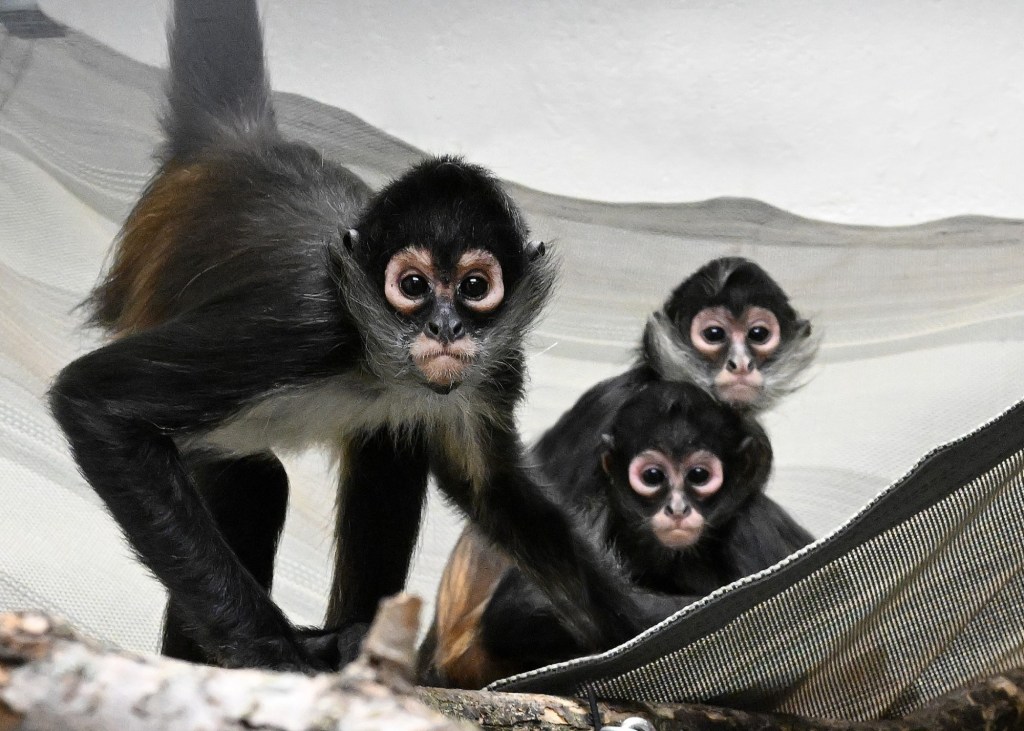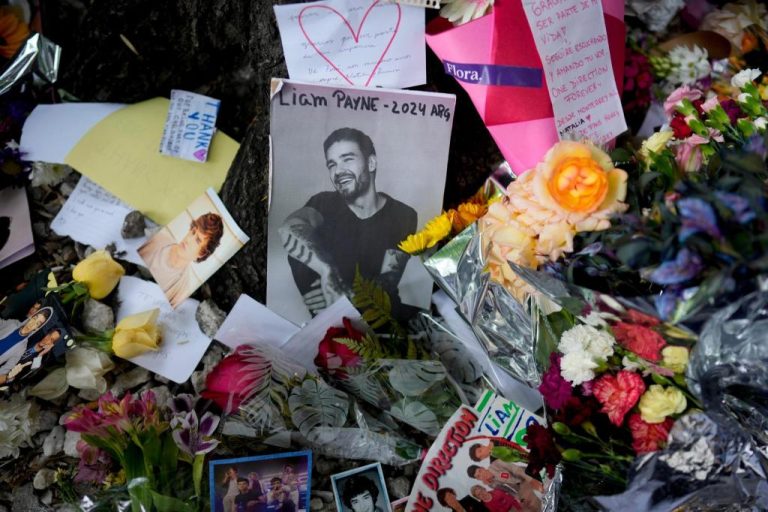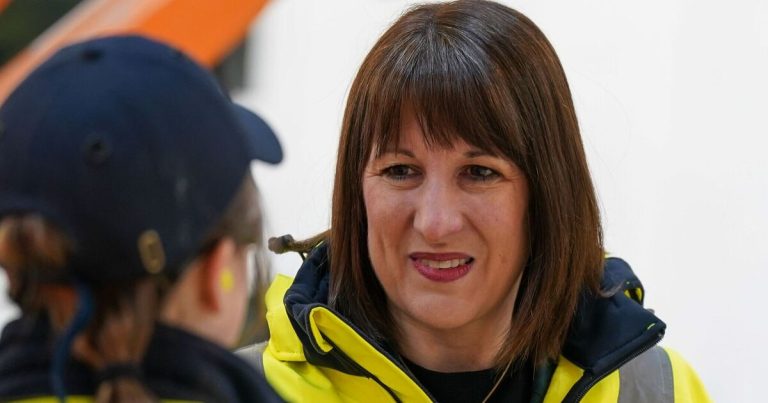
Behind the scenes at the Brookfield Zoo, five spider monkeys are preparing to make their public debut this summer. Their journey began more than a year ago when they were confiscated from smugglers at the Mexican border after being snatched from the wild, their mothers killed in the process.
Found malnourished and in diapers, the baby monkeys faced a long road to recovery. Three of them, captured together in Tijuana, Mexico, were sent to the San Diego Zoo Wildlife Alliance, and the other two went to the Houston Zoo. They were bottle-fed and socialized by animal care teams for a year and a half.
Now, their new caretakers at the Brookfield Zoo are sharing their story to highlight the illegal exotic pet trade and the threat it poses to endangered animals — especially as many buyers don’t realize the creatures sold on the black market are poached from the wild.
“Their situation early in life was likely very traumatic,” said Kim Skelton, director of primate care and conservation at the zoo. “So a lot of times, when they come to us, or when they get picked up, they’re malnourished, they’re very traumatized.”
Wildlife trafficking is a worldwide, multibillion-dollar criminal enterprise where live animals are sold as pets, for food, medicinal ingredients and leather goods. Other commonly trafficked products include animal parts such as rhino horns and elephant ivory, and plants like timber trees.
“The illegal traffic and trade of wildlife, I think, is something that many people are peripherally aware of,” said Mike Adkesson, president and CEO of the Brookfield Zoo. “But I think a lot of people don’t realize the size and scope and scale of that problem, and that a lot of it also includes the transport of live animals … and the really irreparable damage that it’s having on our planet and wildlife populations as a whole.”
Between 2015 and 2019, the U.S. Fish and Wildlife Service intercepted almost 50,000 live specimens at U.S. ports of entry. More than 1,300 of those were confiscated in Chicago — making it the port with the fifth highest number of live animals seized after Miami, which led with a whopping 18,671, and El Paso, Los Angeles and Dallas-Fort Worth with several thousand each.
“While this (information) is five years old, I will say it’s probably a pretty good representation of the illegal trade as a whole,” said Sara Walker, senior adviser at the Wildlife Trafficking Alliance of the Association of Zoos and Aquariums, which analyzed data from the wildlife service for the most recent report.
In the United States, adding to the demand for the illegal wildlife trade is the fact that federal law doesn’t restrict people from owning primates as pets. Walker said spider monkeys are a popular exotic pet and, according to a wildlife service agent interviewed by Texas Monthly, one can sell for thousands of dollars. Other popular primates peddled as pets include lemurs and capuchins, Walker said.
“The problem with wildlife trafficking is, it’s a low-risk, high-reward crime,” she said. “They want to make a buck, and they don’t care about the welfare of the individual animal.”
However, it is illegal in the United States to trade wildlife that is classified as endangered. That is the case for most spider monkey species: one is critically endangered, five are endangered and one is vulnerable, according to the International Union for the Conservation of Nature. The newcomers at the Brookfield Zoo are all Ateles geoffroyi vellerosus, a subspecies of Geoffroy’s spider monkey, which is endangered.
Under the Endangered Species Act, any person who — between states and in foreign commerce — knowingly transports, sells, buys or receives any species listed as endangered or threatened has committed a crime that can be punished by up to one year in prison and fines of up to $50,000; other civil penalties might also apply.
“Although they may be adorable, cute and cuddly as babies, they grow up into animals that do not make suitable pets,” Adkesson explained. “They really should not be in the hands of private individuals.”
After being trafficked, animals need round-the-clock attention, which means they inevitably imprint on and get attached to human caregivers. This makes it unlikely they can ever return to the wild, and their care is a lifetime commitment throughout their 50-year lifespans — something best left to professionals, experts say.
That expertise has contributed to the full recovery of the five spider monkeys.
“It’s pretty remarkable how they’ve bounced back,” said Skelton. “They’ve been adjusting really well. And they’re super curious, they’re super attached to one another. I think they find a lot of comfort in having each other.”

In the wild, these creatures live in large groups or troops with social structures, so conservation groups place rescued spider monkeys with others in similar circumstances or integrate infants into existing troops. The group of five rescues at the Brookfield Zoo was no different, and the young monkeys are learning to rely on each other as they get used to construction noises and strangers behind the scenes at the zoo.
“Anytime something weird happens, they tend to go and either sit close to each other or embrace — which is very cute,” Skelton said.
The spider monkeys will share an enclosure with older capuchin monkeys as part of the Brookfield Zoo’s Tropical Forests exhibit set to open in the summer, which will also be home to gorillas, orangutans and other primates in outdoor habitats.
‘From the large to the small’
The suburban zoo’s role in rehabilitating confiscated animals dates back decades, due in part to its proximity to O’Hare International Airport, one of the country’s busiest and a key entry point into the country.
In the 1980s, one of several major wildlife trafficking stings in Illinois involved an international shipment of falcons through O’Hare. In 1996, the wildlife service created an exhibit in the international terminal to educate travelers about the illegal wildlife trade; at the time, it was the first of its kind at a U.S. airport. A similar exhibit exists today, installed near Gate M18 in Terminal 5 in 2023 as a collaboration between the Lincoln Park Zoo and the Wildlife Trafficking Alliance.
Seven years ago, the wildlife service intercepted critically endangered Chinese giant salamanders at the airport. After a successful recovery at the Brookfield Zoo, the amphibians were sent to another accredited zoo when they got too big for their enclosures — the species can grow to be almost 6 feet long.
“The long-term goal is to hopefully be able to get some of these salamanders reproducing in zoos, to be able to do reintroduction programs back into the wild,” Adkesson said.
In 1977, a family of 10 callimicos, or Goeldi’s monkeys, arrived at the Brookfield Zoo after the U.S. Customs Service seized them as they were being smuggled through Miami. Since then, the zoo developed a critical and award-winning captive-breeding program for the endangered species native to South America, with 330 recorded births in its first 27 years, according to Tribune reporting.

Conservationists hope that seized animals, once rehabilitated, can breed offspring that will further scientific understanding, like the Goeldi’s monkeys, or that can be released into their natural habitat, like the giant salamanders.
“These animals, when they are illegally trafficked and when they’re confiscated,” Adkesson said, “go on to be part of breeding populations at zoos that hopefully are contributing conservation impact back into the wild to protect their counterparts.”
Even insects are trafficked. A giant Indian forest scorpion and elephant beetle larvae were rescued in 2022. The beetles had short lifespans after maturing, but the arachnid can be seen in the Fragile Kingdom desert and rainforest exhibit.
“Many people would be surprised to know that there’s this underground trade in insects and arachnids, and it’s actually (causing) really irreparable harm to wild populations,” Adkesson said. “From a conservation standpoint, we’re just beginning to scratch the surface of understanding the damage that’s being done to insect populations around the globe.”

He said the crucial role of insects in food webs, from pollinating plants to being a food source for other animals, means the foundation of entire ecosystems is being eroded by their illegal trade.
“We’re trying to fight this conservation battle on all fronts, from the large to the small,” Adkesson said. “And there’s a limited number of resources available for protecting specific animals and specific species — and insects often end up at the low end of that list of animals that we choose to invest in. But you could argue that they’re some of the most critical.”
There are, however, conservation programs entirely focused on insects, such as the St. Louis Zoo, which is breeding and reintroducing endangered American burying beetles to southwest Missouri to continue their important role of recycling decomposing components back into the environment.
“It takes just as much in terms of resources to help get an insect back into the wild, in many cases, as it does to get a larger animal back into the wild,” Adkesson added.
Conservation challenges
Rescues of smuggled spider monkeys at the southern border have made headlines over the past months. On New Year’s Eve recently, a baby spider monkey was found in a Rolls-Royce during a traffic stop in California. She was underfed and had an upper respiratory infection, and was taken to the Oakland Zoo in critical condition.
After receiving care for dehydration and malnourishment, the small primates are often rehomed at U.S. zoos or returned to Mexican authorities. The smuggling operations also can cause psychological distress and confinement in small spaces, which can cause injury and even death.
The Wildlife Trafficking Alliance launched in October 2023 a pilot program in Southern California for a first-of-its-kind network that coordinates and centralizes a response between local law enforcement and receiving facilities for the placement and care of wildlife that has been confiscated at the state’s border with Mexico. Since then, the network has helped place almost 4,000 animals.
Some live wildlife is confiscated in very large numbers, like corals and clams, which are part of the predominant aquatic invertebrate trade in Southern California. But housing hundreds of these creatures can be challenging because of the “sheer number of them,” Walker said.

On the other hand, spider monkeys are not confiscated in such large groups. However, they present their own challenge, requiring immediate veterinary care and disease quarantine and, later, careful placement into social groupings.
“So, two spider monkeys can be just as difficult as 500 corals,” Walker said.
The illegal animal trade has repercussions far beyond the animals being smuggled and species populations being decimated by poaching.
“It clogs up our port systems. It slows things down in shipments; there’s delays caused by confiscations like these,” Skelton said. “The federal government and local governments putting time, energy and budget into stopping (wildlife trafficking) is pretty impactful. If it didn’t exist, that money could go elsewhere.”
Potential wildlife crime can be reported to the wildlife service’s trafficking tips line at 844-397-8477 or online at fws.gov/wildlife-crime-tips.
adperez@chicagotribune.com
Editor’s note: Earlier versions of this story misspelled the name of the director of primate care and conservation at the Brookfield Zoo in some references. Her name is Kim Skelton.
Originally Published:











